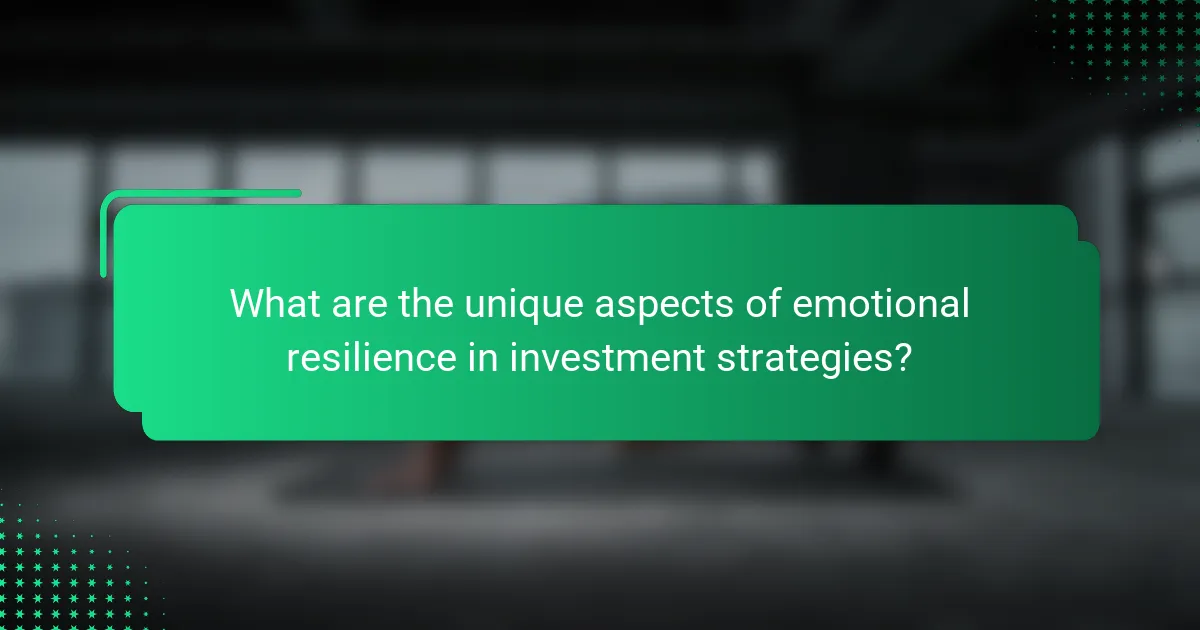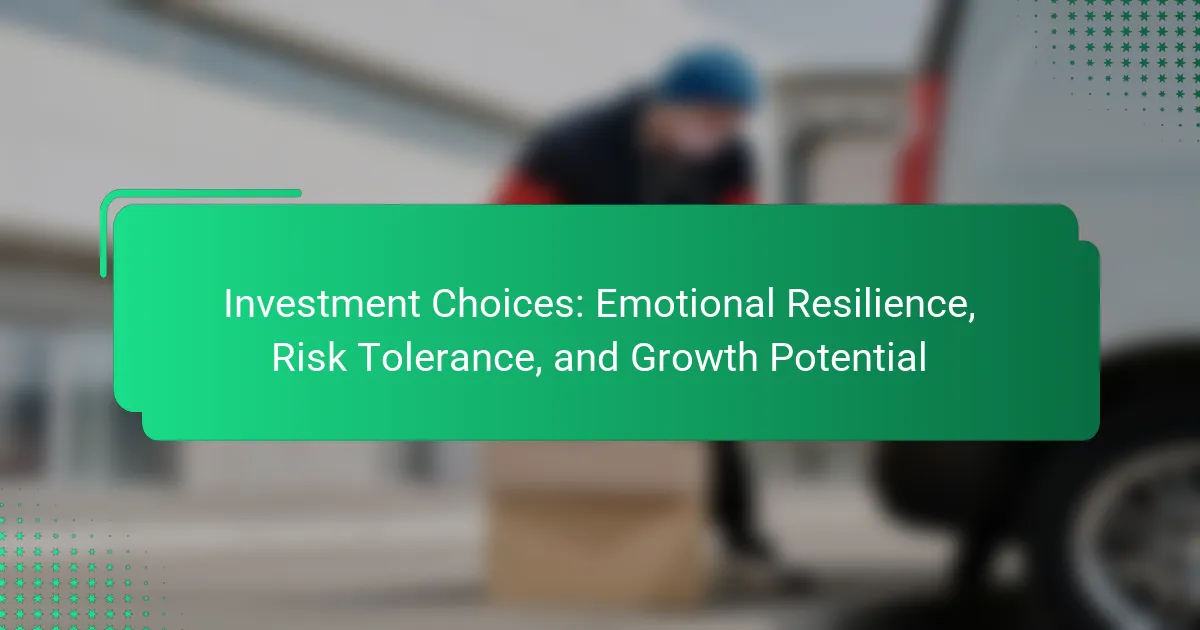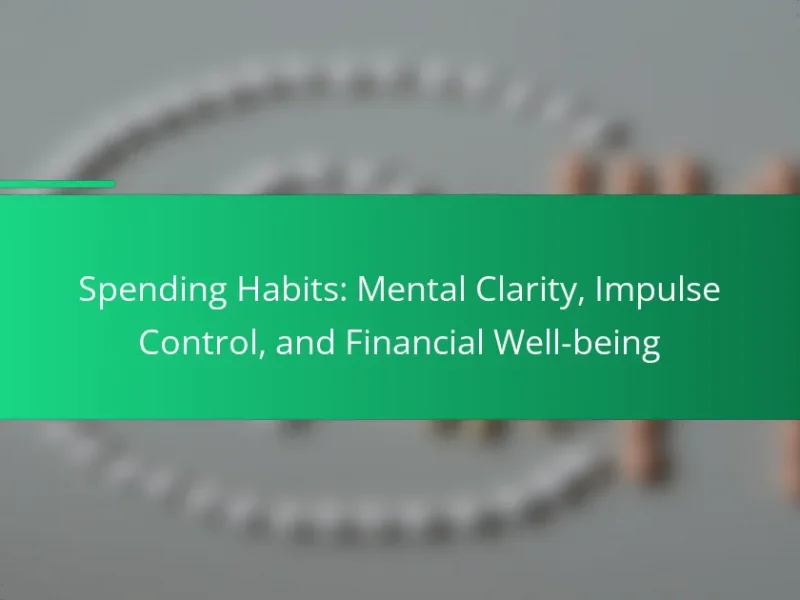Emotional resilience is crucial for making informed investment choices, influencing risk tolerance and decision-making. Understanding the relationship between these factors can enhance long-term growth potential. Key indicators like revenue growth rate and earnings per share provide insights into future profitability. Adapting strategies and maintaining composure during market fluctuations are essential for successful investing.

What is the relationship between emotional resilience and investment choices?
Emotional resilience significantly influences investment choices by affecting risk tolerance and decision-making processes. Individuals with high emotional resilience tend to approach investments more calmly, enabling them to withstand market volatility. This stability can lead to better long-term growth potential as resilient investors are less likely to panic sell during downturns. Research indicates that emotional resilience correlates with a higher likelihood of maintaining a diversified investment portfolio, which further mitigates risk.
How does emotional resilience impact decision-making in investments?
Emotional resilience significantly enhances decision-making in investments by fostering better risk tolerance and analytical thinking. Resilient investors can manage stress and setbacks, allowing them to make more informed choices. This quality also encourages a long-term perspective, promoting growth potential. Studies show that emotionally resilient individuals are less likely to react impulsively to market fluctuations, enabling them to stick to their investment strategies. As a result, they often achieve better financial outcomes compared to those with lower emotional resilience.
What strategies can enhance emotional resilience for investors?
To enhance emotional resilience for investors, focus on developing a strong risk tolerance and a growth mindset. Practicing mindfulness can help manage stress and improve decision-making. Setting realistic investment goals fosters patience during market fluctuations. Regularly reviewing and adjusting strategies based on performance can build confidence and adaptability. Engaging with a supportive community offers shared experiences and insights, reinforcing resilience.
What role does self-awareness play in emotional resilience?
Self-awareness significantly enhances emotional resilience by enabling individuals to recognize and understand their emotions. This understanding helps them manage stress and respond effectively to challenges. Self-aware individuals can assess their risk tolerance more accurately, leading to better investment choices. They are also more likely to learn from setbacks, fostering personal growth and adaptability in uncertain situations.
How can stress management techniques improve investment outcomes?
Stress management techniques can significantly enhance investment outcomes by fostering emotional resilience, improving risk tolerance, and maximizing growth potential. Effective stress management allows investors to make rational decisions, reducing the likelihood of impulsive actions during market fluctuations.
Practicing techniques such as mindfulness or cognitive behavioral strategies can lead to improved emotional stability. This stability helps investors maintain a long-term perspective, aligning their investment choices with their financial goals. As a result, they can better navigate market volatility and avoid emotional reactions that may negatively impact their portfolios.
Furthermore, a resilient mindset enhances risk tolerance. Investors who manage stress effectively are more likely to embrace calculated risks, which can lead to higher returns. Research indicates that emotionally resilient individuals are more adept at recognizing opportunities and acting on them, ultimately contributing to greater growth potential in their investment strategies.

What factors influence risk tolerance in investment choices?
Emotional resilience, financial literacy, and personal experience significantly influence risk tolerance in investment choices. Investors with high emotional resilience can withstand market fluctuations better, leading to more aggressive strategies. Financial literacy enables individuals to understand risks and rewards, shaping their investment decisions. Personal experiences, such as past investment successes or failures, also play a crucial role in determining how much risk one is willing to take.
How can personal financial goals shape risk tolerance?
Personal financial goals significantly influence risk tolerance by aligning investment strategies with individual aspirations. When investors set clear objectives, such as saving for retirement or funding education, they assess risk based on how these goals impact their financial security. A higher risk tolerance often emerges when goals are long-term and growth-oriented, as individuals may be more willing to endure market fluctuations for potentially greater returns. Conversely, short-term goals typically necessitate a lower risk tolerance, emphasizing capital preservation. Understanding this relationship allows investors to tailor their portfolios effectively, balancing emotional resilience with growth potential.
What psychological factors affect an individual’s risk tolerance?
Psychological factors significantly influence an individual’s risk tolerance in investments. Emotions like fear and greed can lead to irrational decisions. Cognitive biases, such as overconfidence, can distort risk perception. Additionally, personal experiences with loss or gain shape future investment behaviors. Social influences and peer pressure also play a role, often leading individuals to conform to group behaviors. Understanding these factors can enhance emotional resilience and improve investment choices.
How does age influence risk tolerance?
Age significantly influences risk tolerance in investment choices. Generally, younger investors tend to have a higher risk tolerance due to their longer time horizon for recovery from potential losses. As individuals age, their risk tolerance typically decreases, reflecting a greater emphasis on capital preservation and income generation.
For example, a study by the Financial Industry Regulatory Authority (FINRA) indicates that individuals in their 20s are more likely to invest in volatile assets compared to those in their 50s and 60s, who often prefer safer investments like bonds. This shift occurs as older investors seek stability and prioritize retirement savings over growth potential.
Moreover, life stages play a crucial role. Young investors may prioritize growth opportunities, while retirees often focus on securing their investments against market fluctuations. This behavioral change highlights the unique attribute of age-related investment strategies, where emotional resilience and financial goals evolve over time.
What role does past investment experience play in shaping risk tolerance?
Past investment experience significantly influences an individual’s risk tolerance. Those with prior exposure to market fluctuations often develop a more nuanced understanding of risk, leading to greater emotional resilience. This experience can shape investment choices, as seasoned investors may be more willing to engage in high-risk opportunities that promise substantial growth potential. Conversely, limited investment experience can result in heightened anxiety around market volatility, causing individuals to favor safer, lower-return options. Ultimately, past experiences serve as a foundation for shaping future investment strategies and risk profiles.

What are the growth potential indicators in investment choices?
Growth potential indicators in investment choices include market trends, economic indicators, and company performance metrics. These factors help assess future profitability and sustainability. Key indicators are revenue growth rate, earnings per share (EPS), and return on equity (ROE). For example, a consistent increase in revenue growth rate signals strong market demand. Additionally, analyzing industry benchmarks can reveal unique attributes that differentiate successful investments. Understanding these indicators fosters emotional resilience and aligns with individual risk tolerance in investment decisions.
How do market trends affect growth potential?
Market trends significantly influence growth potential by shaping investor sentiment and risk tolerance. Positive trends often lead to increased investment, while negative trends can suppress growth. For instance, a bullish market can enhance emotional resilience, prompting investors to take calculated risks. Conversely, a bearish trend may lead to cautious decision-making, impacting overall growth potential. Understanding these dynamics helps investors align their choices with market behaviors, optimizing their investment strategies.
What financial metrics should be evaluated to assess growth potential?
To assess growth potential, evaluate financial metrics such as revenue growth rate, profit margins, return on equity, and cash flow. These metrics provide insights into an entity’s performance and sustainability.
| Metric | Description |
|—————————–|——————————————–|
| Revenue Growth Rate | Percentage increase in sales over time |
| Profit Margins | Ratio of profit to revenue |
| Return on Equity (ROE) | Net income relative to shareholder equity |
| Cash Flow | Net amount of cash generated |
| Earnings Per Share (EPS) | Portion of a company’s profit allocated to each share |
| Debt-to-Equity Ratio | Measure of financial leverage |
How can company performance indicators predict growth potential?
Company performance indicators can effectively predict growth potential by analyzing financial health, market position, and operational efficiency. Key metrics such as revenue growth rate, profit margins, and return on investment provide insights into a company’s ability to expand. For instance, a consistent increase in revenue indicates a strong market demand and effective business strategies. Additionally, evaluating risk tolerance and emotional resilience among investors can influence investment decisions, ultimately impacting growth trajectories. These indicators collectively form a robust framework for assessing future growth opportunities.
What external economic factors should investors consider?
Investors should consider external economic factors such as inflation rates, interest rates, and geopolitical stability. These factors significantly influence market conditions and investment performance. Inflation affects purchasing power and asset values. Interest rates determine borrowing costs and can impact stock market performance. Geopolitical stability influences investor confidence and market volatility. Understanding these elements enhances emotional resilience and risk tolerance while identifying growth potential.

What are the unique aspects of emotional resilience in investment strategies?
Emotional resilience in investment strategies involves maintaining composure during market fluctuations. This unique aspect enables investors to make informed decisions despite emotional stress. High emotional resilience correlates with better risk tolerance, allowing for long-term growth potential. Investors with this trait can adapt to changing market conditions, ultimately enhancing portfolio performance.
How do cultural differences impact emotional resilience in investing?
Cultural differences significantly influence emotional resilience in investing by shaping risk tolerance and decision-making processes. For instance, collectivist cultures often prioritize group consensus, leading to more cautious investment strategies. In contrast, individualistic societies may embrace higher risks, fostering a greater potential for growth. Emotional responses to market fluctuations also vary; cultures that emphasize emotional expression may react more strongly to losses, impacting their investment choices. Understanding these cultural nuances can enhance investment strategies and improve overall resilience in volatile markets.
What role does community support play in enhancing emotional resilience?
Community support significantly enhances emotional resilience by providing a network for sharing experiences and coping strategies. This support fosters a sense of belonging, which can mitigate feelings of isolation during challenging times. Research indicates that individuals with strong community ties exhibit higher levels of emotional resilience, demonstrating a unique attribute of social connectedness that contributes to overall well-being. Engaging in community activities can also lead to improved mental health outcomes, as shared experiences often lead to collective growth and understanding.

What rare attributes can differentiate successful investors?
Successful investors often possess rare attributes that set them apart. These include adaptability to market changes, the ability to learn from failures, and an innovative mindset that drives unique investment strategies. Such traits enable them to navigate uncertainty effectively and capitalize on emerging opportunities.
What uncommon strategies do top investors use to manage risk?
Top investors use unconventional strategies like diversification into alternative assets, behavioral finance insights, and scenario planning to manage risk effectively. These methods enhance emotional resilience and adapt to varying market conditions.
Diversifying into alternative assets, such as real estate or commodities, can mitigate risks associated with traditional stocks and bonds. Behavioral finance insights help investors understand their emotional responses to market fluctuations, allowing for more rational decision-making. Scenario planning prepares investors for various potential market outcomes, enabling them to adjust strategies proactively.
These uncommon strategies emphasize a holistic approach to risk management, focusing on growth potential while maintaining emotional stability in investment choices.
How can unconventional investment choices lead to high growth potential?
Unconventional investment choices can significantly enhance growth potential by diversifying portfolios and tapping into emerging markets. These investments often carry higher risks, attracting individuals with strong emotional resilience and risk tolerance. For example, investing in startups or cryptocurrencies can yield substantial returns if managed wisely. Additionally, alternative assets like art or real estate in up-and-coming areas may appreciate rapidly, offering unique opportunities for growth. Engaging with unconventional investments encourages innovative thinking and adaptability, essential traits for navigating dynamic financial landscapes.

What best practices can improve investment choices based on emotional resilience and risk tolerance?
To improve investment choices based on emotional resilience and risk tolerance, focus on self-awareness and strategic planning. Recognizing personal emotional triggers enhances decision-making. Diversifying investments reduces risk, aligning with individual tolerance levels. Regularly reviewing and adjusting portfolios fosters growth potential while maintaining emotional stability. Engaging with financial advisors can provide tailored strategies to navigate market fluctuations effectively.
How can investors create a personalized investment strategy?
Investors can create a personalized investment strategy by assessing their emotional resilience, risk tolerance, and growth potential. Understanding these factors allows investors to align their choices with their financial goals and market conditions.
Emotional resilience influences decision-making during market volatility. Investors with high resilience can withstand fluctuations without panic selling. Risk tolerance defines the level of risk an investor is comfortable taking, impacting their asset allocation. Growth potential assesses the expected return on investments, guiding choices towards high-growth opportunities.
By evaluating these attributes, investors can tailor their strategies to fit their unique profiles, ensuring a balanced approach that aligns with their long-term objectives.
What common mistakes should investors avoid to enhance emotional resilience?
Investors should avoid emotional decision-making, overreacting to market volatility, and neglecting research. Staying informed about market trends enhances emotional resilience. Establishing a clear investment strategy aligned with risk tolerance fosters discipline. Regularly reviewing and adjusting portfolios helps maintain focus on long-term growth potential.
What expert insights can guide effective investment decisions?
Effective investment decisions hinge on emotional resilience, risk tolerance, and growth potential. Understanding these factors can enhance long-term financial success.
Emotional resilience allows investors to withstand market fluctuations. It fosters a disciplined approach, minimizing impulsive decisions during volatility.
Risk tolerance defines the level of risk an investor is comfortable taking. Assessing this attribute helps tailor investment strategies to individual preferences and financial goals.
Growth potential evaluates the likelihood of an investment appreciating over time. Analyzing market trends and historical performance can guide choices toward high-growth opportunities.


